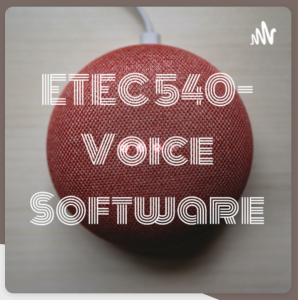For the final project, I chose to examine the communications technology of voice software, pertaining to both text-to-speech and speech-to-text. Please enjoy the below podcast as my final submission for ETEC 540.

References
Eddy, S. R. (2004). What is a hidden Markov model?. Nature biotechnology, 22(10), pg. 1315-1316.
Edwards, K. (2008). Examining the impact of phonics intervention on secondary students’ reading improvement. Educational Action Research, 16, 545–555. doi:10.1080/09650790802445726
Fisher, T. (2019, October 9). How AI and voice technology will transform healthcare. TED. https://www.youtube.com/watch?v=GU8-2bvxCKg&t=4s
Fine, S., Singer, Y., & Tishby, N. (1998). The hierarchal hidden Markov model: Analysis and applications. Machine Learning, 32(1), pg. 41-62.
Gruner, S., Ostberg, P., & Hedenius, M. (2018). The compensatory effect of text-to-speech technology on reading comprehension and reading rate in Swedish schoolchildren with reading disability: The moderating effect of inattention and hyperactivity symptoms differs by grade groups, Journal of Special Education, 33(2), pg. 98-110. DOI: 10.1177/0162643417742898
Huang, Y.M., Liu, C.J., Shadiev, R., Shent, M.H., & Hwang, W.Y. (2014). Investigating an application of speech-to-text recognition: A study on visual attention and learning behaviour. Journal of Computer Assisted Learning, 31(1). Pg. 529-545. doi: 10.1111/jcal.12093
Joshi, S., Kumari, A., Pai, P., Sangaonkar, S., & D’Souza, M. (2017). Voice recognition system. Journal for Research, 3(1). pg. 6-9.
Lowerre, B.T. (1976). The HARPY speech recognition system. (Publication no. 15213). [Doctoral dissertation, Carnegie-Mellon University]. https://stacks.stanford.edu/file/druid:rq916rn6924/rq916rn6924.pdf
Pieraccini, R. (2012). From AUDREY to Siri. Is speech recognition a solved problem. [Powerpoint Slides]. International Computer Science Institute. https://www.icsi.berkeley.edu/pubs/speech/audreytosiri12.pdf
Robertson, B. (2016). How does speech-recognition software work? Science and Children, 54(3). pg. 64-68.
Schalkwyk, J., Beeferman, D., Beaufays, F., Byrne, B., Chelba, C., Cohen, M., Garret, M & Strope, B. (2010). “Your word is my command”: Google search by voice: A case study. Advances in speech recognition (pp. 61-90).
Shaywitz, S. E., Shaywitz, B. A., Fletcher, J. M., & Escobar, M. D. (1990). Prevalence of reading disability in boys and girls: Results of the Connecticut longitudinal study. Journal of the American Medical Association, 264, 998–1002. doi:10.1001/jama.1990.03450080084036
Stinson, M.S., Elliot, L.B., Kelly, R.R., & Liu, Y. (2009). Deaf and hard-of-hearing students’ memory of lectures with speech-to-text and interpreting/note-taking services. The Journal of Special Education, 43(1). Pg. 52-64. https://doi.org/10.1177%2F0022466907313453
Strauss, S., & Xiang, X. (2006). The writing conference as a locus of emergent agency. Written Communication, 23(4), 355–396.
Yaco, S. (2007). The potential for use of voice recognition software in appraisal and transcription of oral history tapes. ARSC Journal, 38(2). pg. 214-225.
Young, C. & Stover, K. (2013). “Look what I did” Student conferences with text-to-speech software. The Reading Teacher, 67(4). pg. 269-272. DOI:10.1002/TRTR.1196